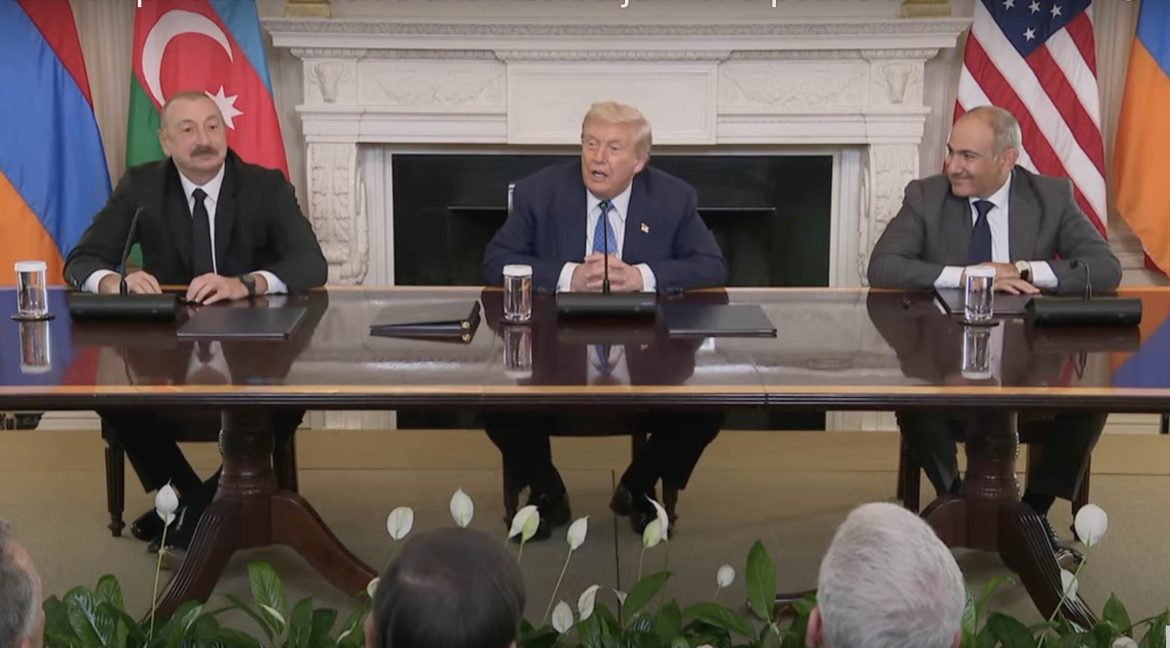Armenian Prime Minister Nikol Pashinyan and Azerbaijani President Ilham Aliyev signed a historic peace agreement at the White House on 8 August, formally ending more than three decades of conflict over the Nagorno-Karabakh region.
The deal was brokered by U.S. President Donald Trump, whose administration has sought to increase American influence in the South Caucasus amid Russia’s ongoing geopolitical retreat.
The ceremony took place in the State Dining Room, where both leaders joined Trump to mark what they described as a decisive turning point. The agreement, which now awaits parliamentary ratification in both countries, establishes a new transit corridor connecting Azerbaijan with its Nakhchivan exclave through Armenian territory.
According to U.S. officials, the corridor will be named the Trump Route for International Peace and Prosperity (TRIPP) — a designation reportedly proposed by the Armenian side. The route is set to accommodate rail, oil and gas infrastructure, and fibre optic lines, with negotiations over development rights scheduled to begin next week. At least nine international consortia have already expressed interest.
Strategic Shift in the South Caucasus
The agreement includes bilateral treaties between each country and the United States aimed at enhancing cooperation in energy, infrastructure, and technology. It also envisages the reopening of key transportation links across the region, previously closed due to decades of hostilities.
White House spokeswoman Anna Kelly described the agreement as a “roadmap to build a cooperative future,” while reaffirming that Armenian sovereignty and territorial integrity would be fully respected under the deal. “This will allow unimpeded connectivity while safeguarding national borders and populations,” she stated.
The TRIPP corridor bridges a 32-kilometre gap between Azerbaijan proper and the autonomous Nakhchivan region, long a point of contention. Baku had previously demanded a land bridge under its own or neutral control, while Yerevan resisted third-party oversight. Under the new agreement, the corridor will remain under Armenian jurisdiction but be developed with U.S. financial and logistical support.
Political Reactions
Both Pashinyan and Aliyev hailed the agreement as a diplomatic breakthrough.
“We are laying the foundation to write a better story than the one we had in the past,” Pashinyan said.
Aliyev echoed the sentiment, calling the transit project “a path toward strategic partnership” and crediting Trump for his role. “President Trump in six months did a miracle,” he remarked, joining calls from international observers for the U.S. leader to be nominated for the Nobel Peace Prize.
Trump himself stated: “Thirty-five years they fought, and now they’re friends — and they’re going to be friends for a long time.”
Background and Geopolitical Implications
Armenia and Azerbaijan have been locked in conflict since the collapse of the Soviet Union, with major outbreaks of violence occurring in the early 1990s, 2020, and 2023. The latter saw Azerbaijan fully reclaim Nagorno-Karabakh, effectively dissolving the ethnic Armenian administration. The region’s Armenian population fled in large numbers following the September 2023 offensive.
The new agreement marks the first formal bilateral peace declaration between the two countries since the end of the Cold War. As part of the accord, both governments have signed a letter to the Organisation for Security and Cooperation in Europe (OSCE) requesting the formal dissolution of the Minsk Group — the long-standing tripartite body co-chaired by the U.S., Russia, and France that had failed to deliver a sustainable peace framework.
The White House stated that the OSCE group is “no longer relevant.”
Analysts view the deal as part of a broader U.S. strategy to capitalise on Russia’s waning influence in the region. Following its 2022 invasion of Ukraine, Moscow has struggled to maintain its traditional mediator role in the South Caucasus. Armenia, disillusioned by Russia’s inaction during Azerbaijan’s recent offensives, has pivoted westward. Baku, meanwhile, has grown increasingly assertive in distancing itself from Moscow.
Steve Witkoff, Trump’s diplomatic envoy, is credited with initiating the talks earlier this year during a visit to Baku, where he outlined a “regional reset” strategy focused on infrastructure integration and energy independence.
Wider Context of U.S. Diplomacy
The Armenia–Azerbaijan peace deal is the latest in a series of diplomatic initiatives led by the Trump administration in 2025. It follows a ceasefire brokered between India and Pakistan, an agreement between the Democratic Republic of Congo and Rwanda, and U.S. intervention in Southeast Asia to prevent escalation between Cambodia and Thailand.
However, attempts to resolve the conflicts in Gaza and Ukraine have not produced comparable results.
Trump previewed the South Caucasus agreement on his Truth Social platform the evening before the signing, writing: “Many Leaders have tried to end the War, with no success, until now, thanks to ‘TRUMP.’”
While political debate continues over the implications of naming international infrastructure after a sitting U.S. president, the administration maintains that the proposal originated with Armenian negotiators.
Asked whether he plans to visit the newly agreed corridor, Trump replied: “We’re going to have to get over there.”
Next Steps
The peace agreement must be ratified by the Armenian National Assembly and the Azerbaijani Milli Majlis. While support in Azerbaijan is expected to be strong, ratification in Armenia could be politically sensitive, with nationalist opposition groups already voicing objections to provisions related to territorial access.
Nonetheless, U.S. officials expressed “high confidence” in the durability of the framework and its capacity to shift the regional balance toward stability and economic integration.
The implementation phase will include formal demarcation, infrastructure planning, and long-term development agreements involving U.S. firms and local governments.
If successful, the deal may redefine the geopolitical dynamics of the South Caucasus, replacing decades of confrontation with a U.S.-anchored strategic corridor linking Central Asia to Europe.
The Illusion of Detour: Russia’s Warpath and the Futility of Trump’s Peace Proposal


